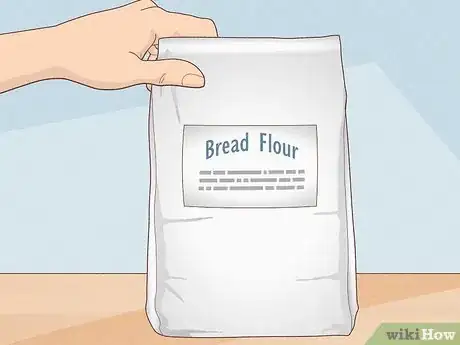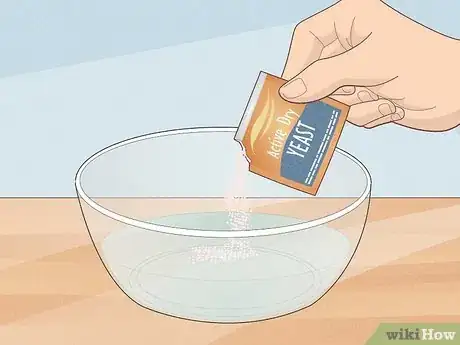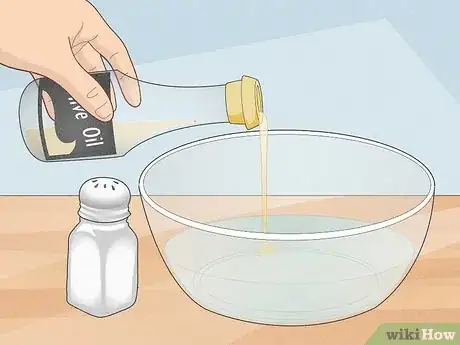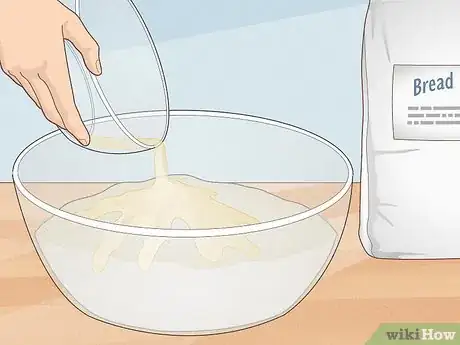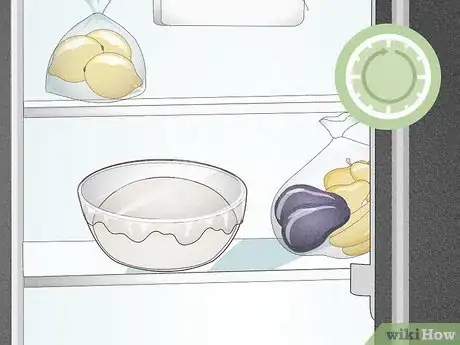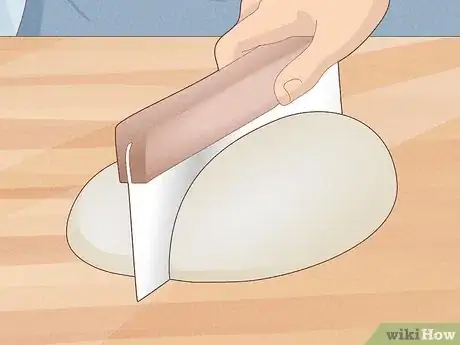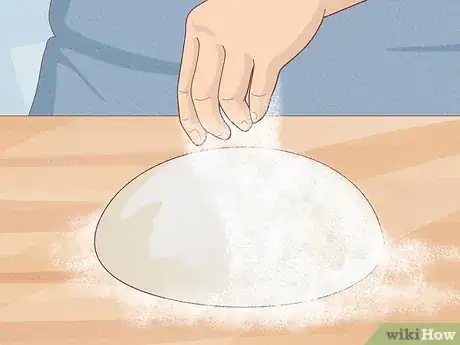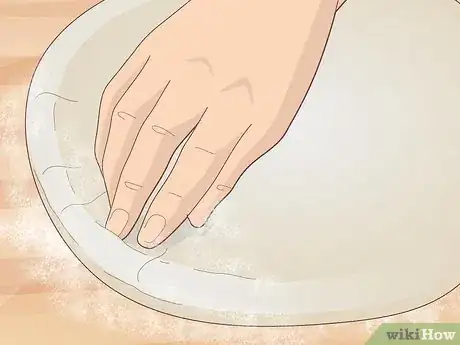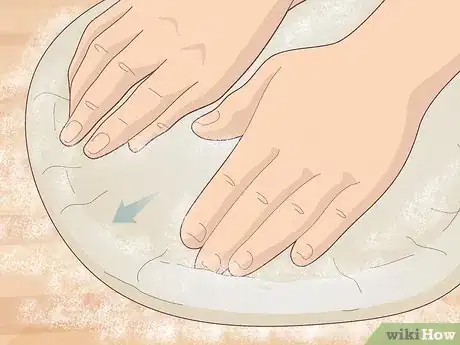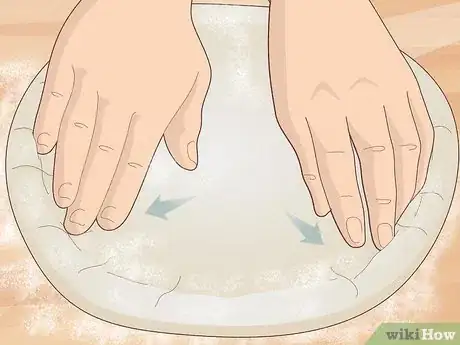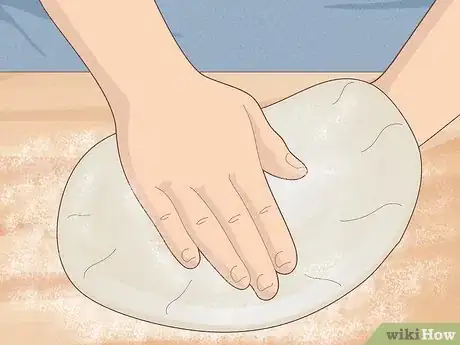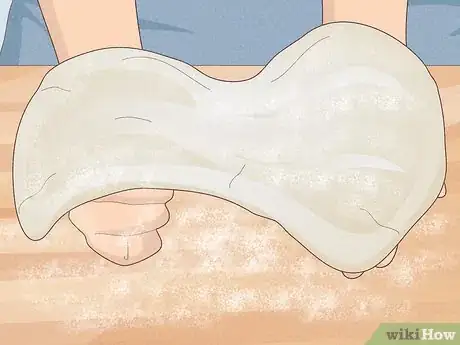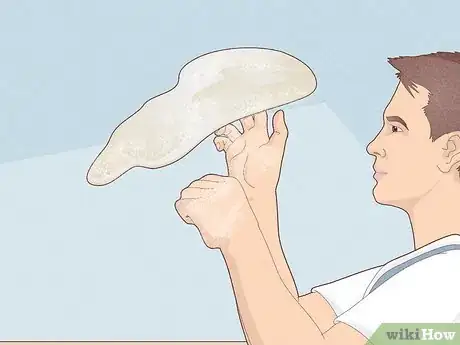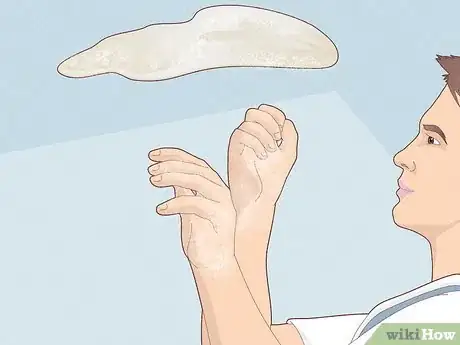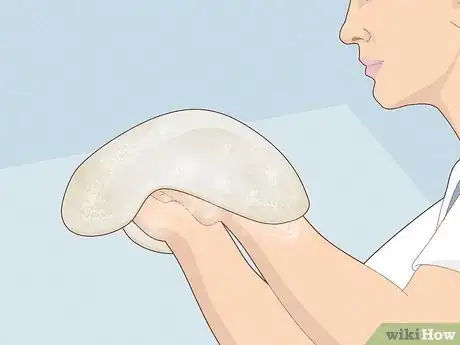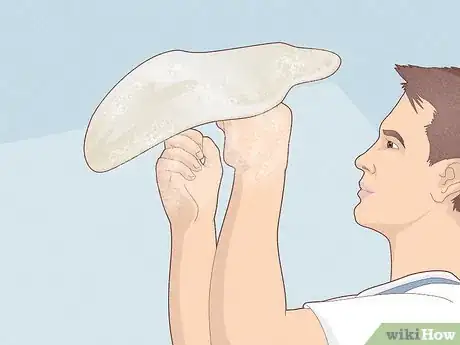This article was co-authored by Ollie George Cigliano. Ollie George Cigliano is a Private Chef, Food Educator, and Owner of Ollie George Cooks, based in Long Beach, California. With over 20 years of experience, she specializes in utilizing fresh, fun ingredients and mixing traditional and innovative cooking techniques. Ollie George holds a BA in Comparative Literature from The University of California, Berkeley, and a Nutrition and Healthy Living Certificate from eCornell University.
There are 10 references cited in this article, which can be found at the bottom of the page.
wikiHow marks an article as reader-approved once it receives enough positive feedback. In this case, 85% of readers who voted found the article helpful, earning it our reader-approved status.
This article has been viewed 315,245 times.
If you plan to toss, start with the recipe. Without the right kind of flour and the right approach, your dough will not develop the gluten it needs for a strong, stretchy texture. Once you have the right recipe, practice shaping and tossing until you become a true pizzaiolo. Not all pizza chefs toss their dough, but it is an excellent way to flatten and widen your dough with minimal compression, keeping the dough light.[1]
Ingredients
- 1 cup (240mL) warm water
- 1 cup (240mL) ice cold water
- 1/2 tablespoon (7.5mL) salt
- 1 tablespoon (15mL) sugar
- 2 tablespoon (30mL) olive oil
- 1 packet active dry yeast
- About 5½ cups (685g) flour
Steps
Making the Dough
-
1Choose your recipe. Most pizza chefs experiment with dozens of recipes before they find their personal, perfect pizza. If you don't have a personal favorite yet, the recipe described here makes a strong, Neapolitan-style pizza that should resist tears while tossing.
- Your quest will be easier if you familiarize yourself with baking percentages, and keep detailed notes on each recipe.[2]
-
2Choose your flour. The flour's protein content is incredibly important for pizza, especially when you plan to toss it. Look for bread flour or pizza flour with a protein content of at least 12.5%.[3]Advertisement
-
3Mix the yeast into warm water. The water should be "blood temperature," or close to 96ºF (35.5ºC). Let this mixture stand until the yeast is dissolved and begins to bubble.
-
4Mix wet ingredients together. Mix cold water, sugar, salt, and olive oil in a separate bowl.
-
5Combine all ingredients. Place the flour in a large bowl. Stir the activated yeast, then pour it into the flour. Pour the cold water mixture as well.
-
6Knead the dough. You may knead by hand or with a dough hook attached to a low-speed electric mixer. Knead until the dough is glossy and tacky, but not sticky. You should be able to pinch a small piece and pull it thin enough to let light pass through. This is a sign of a strong, high-gluten dough that will stay together when tossed, and make a chewy, tender crust.
- Results can vary with humidity and other unpredictable factors. Add a little flour if the mixture is sticky, or a little water if the dough is dry.
- This usually takes 5–15 minutes by hand, or 2–4 minutes in an electric mixer.
-
7Let rise overnight. Brush the dough with olive oil and store, covered, in the refrigerator. Leave overnight (or for at least 5 hours) to allow gluten to develop further. The cold temperature of the fridge slows yeast activity, preventing excessive rising from the long waiting period.[4] Cold dough is also easier to handle.
- Place the dough in an airtight container with enough room for the dough to double in size.
- Alternatively, leave covered with a warm towel for 40–60 minutes at room temperature, or until dough doubles in size. Chill for one hour in the refrigerator.
Shaping the Dough
-
1Cut the dough ball in half. Scoop up the dough ball with a dough scraper, if you have one, to avoid stretching it. Cut it in half to form the dough for two smaller pizzas. These will be more convenient to handle and fit in a home oven. For the instructions below, use one dough ball at a time.
- Make sure that your pizza dough is room temperature before you start working with it.[5]
-
2Coat generously with flour. Coat both sides with plenty of flour. Drop the dough ball on a flat, floured surface, flipped over so the side that was underneath while rising is now on top.[6] [7]
- To reduce mess, use cornmeal or semolina instead of regular flour.[8]
- If your dough or hands stick at any point during the rest of the process, add more flour.
-
3Flatten the dough. Slap the ball of dough flat with your hand, kept as flat as possible. Don't press too hard, or you'll squeeze out the air and create a hard, dense crust. Just press until it is relatively flat, but still squishy.
-
4Define the outer crust. Hold your fingers straight and together. Press into the dough about 1⁄2 inch (1.3 cm) from the edge. Repeat this motion around the whole circle, forming a groove and a raised outer crust.
-
5Push the dough outward. Keep your fingers straight and together. Hold your hands flat, just above the dough, with your fingers pressing into the groove you just made. Fan your fingers outward a little, pressing against the crust. Bring your fingers together and rotate the dough a little, then repeat this fanning motion around the whole edge.[9] This will make the outer crust edge thinner, and the pizza a bit larger.
- Don't press your palms against the base of the dough. This can lead to uneven crust or tears.
- Beginners can use a rolling pin when starting out. This is easier, but usually results in a denser crust.
-
6Stretch the dough. Once again, hold your fingers straight and together. Place them lightly on the dough in a comfortable position in front of you, angled toward each other. Press your fingertips against the edge, and push one hand outward to gently stretch that small area of the pizza. Rotate the dough and repeat, moving around the dough several times. With practice, you can use a fluid, fast motion, moving your hands in small circles.[10] Stop when the dough is getting thin, and approaching the size you want.
- Never move your hands in completely opposite directions, as this will create a thin center. Move at an angle instead to stretch just the outer area, leaving a small hump in the center of the dough.[11]
- You can instead press the side of your hand down into the groove, then push directly outward to stretch the edge. Use your other hand to rotate the dough as you go.[12]
Tossing the Dough
-
1Slap the dough between your hands (optional). Slapping is an easier way to hand shape your pizza. Some chefs slap, some toss, and some start with slapping and finish with a toss or two. None of these methods are more correct than another. If you decide to slap, here's how it goes:[13] [14] [15]
- Drape the dough over your palm and forearm. The more of your arm you use, the less likely the dough is to break.
- "Slap" the dough onto your opposite palm, letting it drape over your other hand and forearm. If your dough is in danger of tearing, let it drape gently instead of using force.
- Repeat this motion back and forth. Each time you "slap," the dough should rotate about one quarter turn. This rotation is vital for making the dough wide and even.
-
2Drape the dough on a fist and palm. If your dough looks strong and hasn't yet reached the desired size, it's time to adopt the tossing position. Extend your dominant hand as a flat palm, with fingers together. Keep your other hand in a fist to "anchor" the dough. Drape the pizza dough over both hands, supporting opposite sides of the dough.[16] [17]
-
3Rotate your arms toward your body. Rotate your arms inward to get ready for the throw. (If you are using your right palm, rotate your arms to the left.) This allows more rotation during the throw, imparting the spin that shapes the dough in the air.
-
4Bring your hands up and around. Bring your palm up and around, until the back of your hand is in front of your face.[18] Follow with your fist to continue supporting the pizza, but focus on your palm, which will do the tossing. Practice this motion without tossing the pizza first, then try again with moderate speed during your toss.
- Start with a more gentle throw than you think you need. Too little force, and the pizza doesn't leave your hand. Too much force, and the pizza flies across the room.
-
5Release the pizza. Bring the upward motion of your palm to an abrupt stop when it comes in front of your face. This will send the pizza flying upward a short distance. In the air, it should spin at the same speed your hands rotated. The force from spinning pushes the dough flatter and wider, without pressing out the air.
-
6Follow through. Although your hand stops moving upward, it should still complete the arch of its movement after the pizza is released. Follow through by moving your palm around and out, as though swatting a fly in front of your face. A smooth follow-through ensures that your hand is rotating at the moment when you release the pizza.
- Don't worry too much about this for your first few tosses. It's more important to catch the falling pizza than to get the right hand shape.
-
7Catch the dough. Catch the dough with both fists and forearms. Use as much of your forearm as you can, to avoid puncturing it. If you have a strong dough, you may be able to catch it on one fist, but this is risky for most recipes.
- If you tossed with your right palm, catch the dough mostly on your left arm.
- Expert dough tossers "catch" the dough on their fingertips, sending it spinning again without letting it rest. This is a complex technique that involves sending the dough in multiple trajectories and angles.[19] It's best not to try this until you're a more experience pizzaiolo.
-
8Repeat as necessary. If you slapped the dough or hand-stretched it heavily, you may only need one toss to get your pizza to the size you need. If you only used light hand-stretching, you may toss it several times. Once the pizza reaches the desired size, place the dough on a pizza screen, pizza stone, or baking sheet. You're ready to add the toppings.[20]
- The dough is ready when you say it's ready. The size of your oven and personal preference for crust thickness are the only criteria you need when cooking at home.
Expert Q&A
-
QuestionWhat kind of prepping do I need to do before tossing pizza?
 Ollie George CiglianoOllie George Cigliano is a Private Chef, Food Educator, and Owner of Ollie George Cooks, based in Long Beach, California. With over 20 years of experience, she specializes in utilizing fresh, fun ingredients and mixing traditional and innovative cooking techniques. Ollie George holds a BA in Comparative Literature from The University of California, Berkeley, and a Nutrition and Healthy Living Certificate from eCornell University.
Ollie George CiglianoOllie George Cigliano is a Private Chef, Food Educator, and Owner of Ollie George Cooks, based in Long Beach, California. With over 20 years of experience, she specializes in utilizing fresh, fun ingredients and mixing traditional and innovative cooking techniques. Ollie George holds a BA in Comparative Literature from The University of California, Berkeley, and a Nutrition and Healthy Living Certificate from eCornell University.
Private Chef & Food Educator Remember to prep your pizza-tossing station with "bench flour" (dust a clean and sanitized countertop with flour) and keep an extra bowl nearby.
Remember to prep your pizza-tossing station with "bench flour" (dust a clean and sanitized countertop with flour) and keep an extra bowl nearby. -
QuestionWhat is the ideal size for a pizza disc?
 Ollie George CiglianoOllie George Cigliano is a Private Chef, Food Educator, and Owner of Ollie George Cooks, based in Long Beach, California. With over 20 years of experience, she specializes in utilizing fresh, fun ingredients and mixing traditional and innovative cooking techniques. Ollie George holds a BA in Comparative Literature from The University of California, Berkeley, and a Nutrition and Healthy Living Certificate from eCornell University.
Ollie George CiglianoOllie George Cigliano is a Private Chef, Food Educator, and Owner of Ollie George Cooks, based in Long Beach, California. With over 20 years of experience, she specializes in utilizing fresh, fun ingredients and mixing traditional and innovative cooking techniques. Ollie George holds a BA in Comparative Literature from The University of California, Berkeley, and a Nutrition and Healthy Living Certificate from eCornell University.
Private Chef & Food Educator You should form a disc about 10 inches across and half an inch thick before tossing it. Then, keep tossing it until the dough stretches to around 12 inches or any desired size. There's not really a rule for this.
You should form a disc about 10 inches across and half an inch thick before tossing it. Then, keep tossing it until the dough stretches to around 12 inches or any desired size. There's not really a rule for this.
Warnings
- It is essential to knead the dough long enough, but not too long. If using a powerful electric mixer, it is possible to over-knead. The symptom of this is stringy dough that breaks apart into threads.⧼thumbs_response⧽
- Throwing the dough too high can be disastrous. It will either land too hard and tear, or get stuck to your ceiling. A short hop is all you need.⧼thumbs_response⧽
References
- ↑ http://www.bonappetit.com/test-kitchen/cooking-tips/article/pizza-with-mario-batali
- ↑ http://slice.seriouseats.com/archives/2010/10/pizza-protips-bakers-percentages-how-to-make-pizza-dough.html
- ↑ http://slice.seriouseats.com/archives/2011/06/the-pizza-lab-on-flour-foams-and-dough.html
- ↑ http://www.afamilyfeast.com/sunday-cooking-lesson-perfect-pizza-dough/
- ↑ Ollie George Cigliano. Private Chef & Food Educator. Expert Interview. 18 October 2021.
- ↑ https://www.youtube.com/watch?v=VIJlRXMfW50
- ↑ Ollie George Cigliano. Private Chef & Food Educator. Expert Interview. 18 October 2021.
- ↑ https://www.youtube.com/watch?v=2pb5Fi9t2Ds
- ↑ https://www.youtube.com/watch?v=VIJlRXMfW50
- ↑ https://www.youtube.com/watch?v=AbkfDqA8yKg
- ↑ https://www.youtube.com/watch?v=2pb5Fi9t2Ds
- ↑ https://www.youtube.com/watch?v=2pb5Fi9t2Ds
- ↑ https://www.youtube.com/watch?v=2pb5Fi9t2Ds
- ↑ https://www.youtube.com/watch?v=AbkfDqA8yKg
- ↑ https://www.youtube.com/watch?v=HWL__9yDu8I
- ↑ https://www.youtube.com/watch?v=HWL__9yDu8I
- ↑ Ollie George Cigliano. Private Chef & Food Educator. Expert Interview. 18 October 2021.
- ↑ https://www.youtube.com/watch?v=VIJlRXMfW50
- ↑ http://phys.org/news/2009-04-physics-pizza-tossing.html
- ↑ Ollie George Cigliano. Private Chef & Food Educator. Expert Interview. 18 October 2021.
About This Article
To toss pizza dough, you need to start with a strong, stretchy dough that has been allowed to rise for at least 5 hours. Coat both sides of the dough with plenty of flour, then slap it with your hand to flatten it into a circle. Pick the circle of dough up so you’re holding it across one open palm and one closed fist. Rotate your arms inwards, then bring your hands up and around until the back of your open hand is in front of your face. Lightly toss the dough into the air so it continues to spin, then catch the dough on both of your fists and forearms. If you want to learn how to make your pizza dough, keep reading the article!

